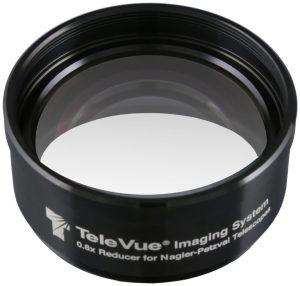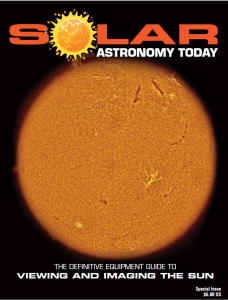A new Tele Vue reducer is now available for Tele Vue NP Imaging System telescopes. The Tele Vue NPR-2073 0.8x Reducer for NP Scopes is specifically designed to be used with the Tele Vue NP127is and NP101is Imaging System telescopes.
 This new Tele Vue reducer minimizes vignetting with camera sensors up to 43mm diagonal (full frame) and is a replacement for the previous Tele Vue 0.8x reducer, the discontinued NPR-1073 (which worked best up to APS-C sensors). When combined with a Tele Vue Petzval-type telescope, the new NPR-2073 reducer reduces the focal length of the telescope by 20% and makes it that much faster. This also increases the telescope’s field of view by 25%.
This new Tele Vue reducer minimizes vignetting with camera sensors up to 43mm diagonal (full frame) and is a replacement for the previous Tele Vue 0.8x reducer, the discontinued NPR-1073 (which worked best up to APS-C sensors). When combined with a Tele Vue Petzval-type telescope, the new NPR-2073 reducer reduces the focal length of the telescope by 20% and makes it that much faster. This also increases the telescope’s field of view by 25%.
The reducer is threaded on both sides for the Tele Vue Imaging System. It attaches to the imaging insert included with the Tele Vue NP127is and NP101is telescopes and the other side accepts all the spacers, camera adapters, and thread converters included in the Tele Vue Imaging System. Back focal length spacing for the reducer is included in the instructions.
The NPR-2073 can also be used to enlarge the field of other Tele Vue Petzval-type telescopes, but will not provide additional correction for those models. For use on Tele Vue Petzval model telescopes with 2-inch focusers, use the Tele Vue Imaging System Nosepiece for 2″ Focuser. This reducer slides into a 2″ telescope drawtube and has a 2.4″ imaging system thread on the other side to accept any Tele Vue imaging system accessory.
You can learn about the new Tele Vue reducer here.

 And to make it easier for you to get the most extensive news, articles and reviews that are only available in the magazine pages of Astronomy Technology Today, we are offering a 1-year magazine subscription for only $6! Or, for an even better deal, we are offering 2 years for only $9. Click here to get these deals which only will be available for a very limited time. You can also check out a free sample issue here.
And to make it easier for you to get the most extensive news, articles and reviews that are only available in the magazine pages of Astronomy Technology Today, we are offering a 1-year magazine subscription for only $6! Or, for an even better deal, we are offering 2 years for only $9. Click here to get these deals which only will be available for a very limited time. You can also check out a free sample issue here.
The Sun is more active than it’s been in years and if that’s not enough, we have the Annular Solar Eclipse on October 14, 2023 and the Total Solar Eclipse on April 8, 2024! If you’d like to learn more about the technology behind solar observing, solar imaging and more, you can check out our free publication, “The Definitive Guide to Viewing and Imaging the Sun”. You don’t have to sign up or provide any information, simply click here and enjoy reading!

